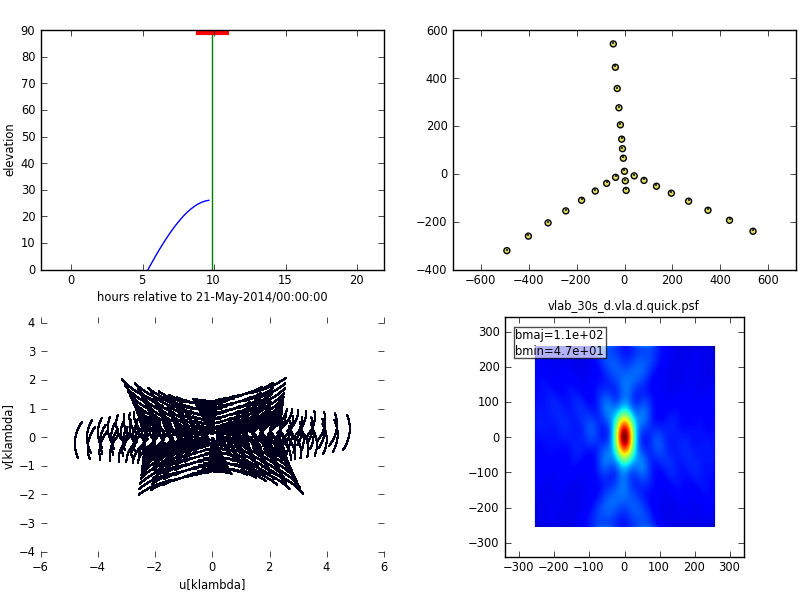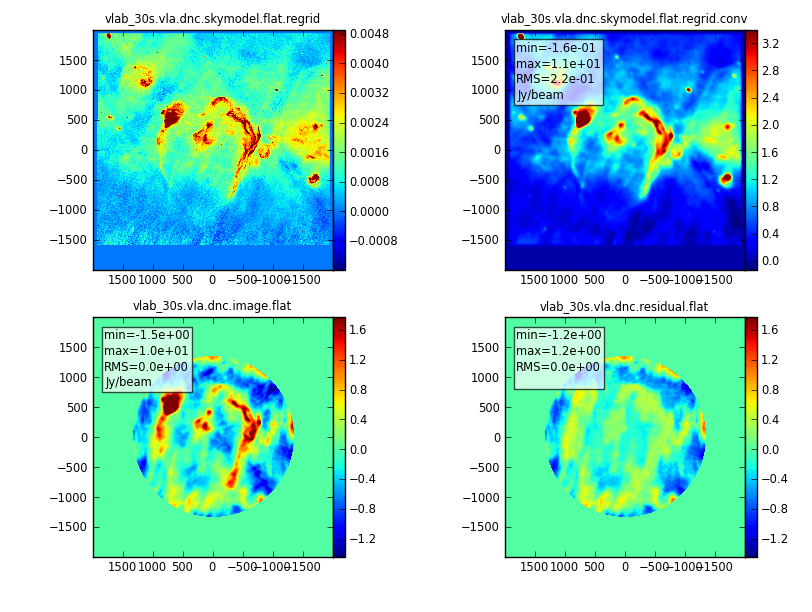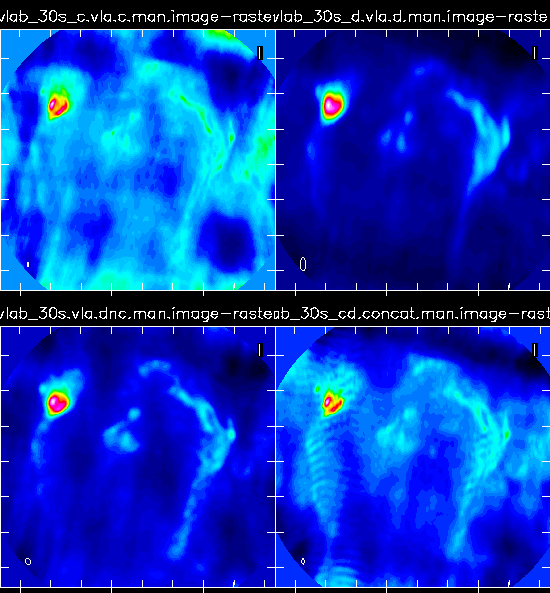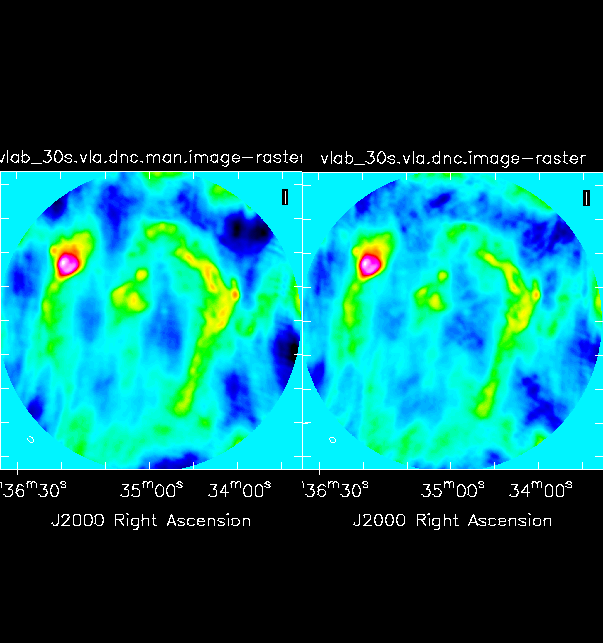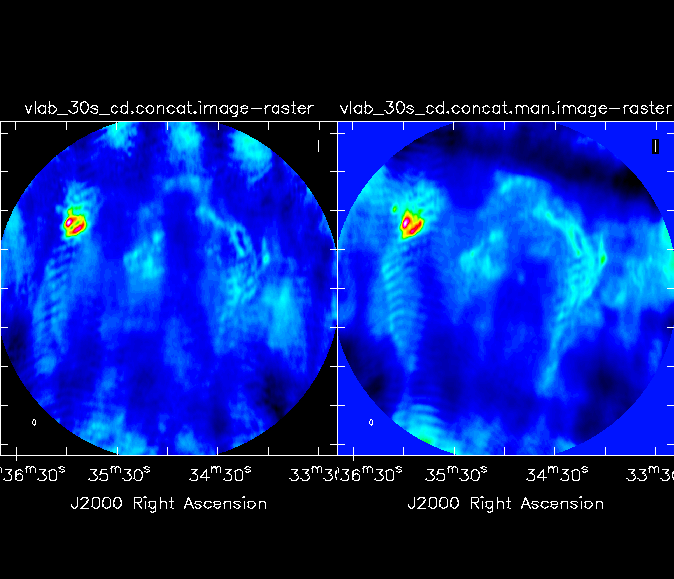VLA Hybrid Array Simulation: Difference between revisions
mNo edit summary |
No edit summary |
||
| (2 intermediate revisions by the same user not shown) | |||
| Line 1: | Line 1: | ||
== Simulating low-declination sources with the VLA == | == Simulating low-declination sources with the VLA == | ||
Historically, VLA has offered "hybrid" configurations e.g. BnA, with extension on the north-south arm, so that sources at low declination achieve a rounder synthesized beam than they would with the standard configurations. | Historically, VLA has offered "hybrid" configurations e.g. BnA, with extension on the north-south arm, so that sources at low declination achieve a rounder synthesized beam than they would with the standard configurations. | ||
more words here describing the images: regular D vs DnC at dec=-30 | |||
[[File:Vlab_30s_d.vla.d.observe.png| | |||
[[File:Vlab_30s_d.vla.d.observe.png|500px]][[File:Vlab_30s.vla.dnc.observe.png|500px]] | |||
more words about how in principle one can combine some D and some C to recreate what one had with DnC | |||
==== Example ==== | |||
I wanted a model image that was public, easy for the user to obtain, actually radio wavelength as opposed to using e.g. a spitzer image, had good spatial dynamic range to start with, and was interesting, so I chose this but I don't know if its the best - if you think something with a bunch of compact structure which will get imaged elongated would be more illustrative, please suggest something. This VLASS has B+C+D originally, so arguably has all relevant spatial scales before we run this new simulation. | |||
Here is the skymodel, skymodel convolved, and simulated, as output by the simanalyze commands below, for 2h DnC: | |||
[[File:Vlab_30s.vla.dnc.image.png]] | |||
Here is 2h at transit in C, 2h in D, \\ | |||
2h in CnD, and 1h in D plus 1d in C | |||
(commands below) | |||
[[File:Vla.4panel.attempt1.png]] | |||
There's clearly a problem with the D plus C clean - I'll look more into it - the skymodel is >2x the PB, so its not an edge effect from the simulation, but it might be insufficient uv coverage in 2x1h snapshots, both at transit. | |||
These are noise-free - should we add thermal noise? I'll run that next to compare. Sometimes noise-free simulations get unstable in the clean because they have unrealistic properties. | |||
I didn't apply any relative weighting between the D an C visibilities, nor did I apply any tapers. Should we do such things? | |||
<source lang="python"> | |||
# 2h CnD | |||
simobserve "vlab_30s",skymodel="snr.fits",antennalist="vla.dnc.cfg",thermalnoise="",verbose=True,incenter="1.4GHz",inwidth="200MHz",indirection="J2000 18h35m00s -30d00m00s",mapsize="15arcsec" | |||
simanalyze "vlab_30s",analyze=True,imsize=2000,niter=5000,threshold="0.3Jy" | |||
# 1hC | |||
simobserve "vlab_30s_cd",skymodel="snr.fits",antennalist="vla.c.cfg",thermalnoise="",verbose=True,incenter="1.4GHz",inwidth="200MHz",indirection="J2000 18h35m00s -30d00m00s",mapsize="15arcsec",totaltime="3600s" | |||
# 1hD in the same directory | |||
simobserve "vlab_30s_cd",skymodel="snr.fits",antennalist="vla.d.cfg",thermalnoise="",verbose=True,incenter="1.4GHz",inwidth="200MHz",indirection="J2000 18h35m00s -30d00m00s",mapsize="15arcsec",totaltime="3600s" | |||
# image and analyze together (simanalyze will automatically concat the two MS it finds in the sim directory | |||
simanalyze "vlab_30s_cd",analyze=True,imsize=2000,niter=5000,threshold="0.2Jy" | |||
</source> | |||
After simanalyze I cleaned manually with masks - we could provide the masks, or just use the un-masked clean in simanalyze - it doesn't look that much worse for DnC: | |||
[[File:Vlab_30s.manclean.auto.png]] | |||
but it does for the concatted 1hC plus 1hD: | |||
[[File:Vlab_30s_cd.manclean.auto.png]] | |||
Latest revision as of 14:35, 20 November 2015
Simulating low-declination sources with the VLA
Historically, VLA has offered "hybrid" configurations e.g. BnA, with extension on the north-south arm, so that sources at low declination achieve a rounder synthesized beam than they would with the standard configurations.
more words here describing the images: regular D vs DnC at dec=-30
more words about how in principle one can combine some D and some C to recreate what one had with DnC
Example
I wanted a model image that was public, easy for the user to obtain, actually radio wavelength as opposed to using e.g. a spitzer image, had good spatial dynamic range to start with, and was interesting, so I chose this but I don't know if its the best - if you think something with a bunch of compact structure which will get imaged elongated would be more illustrative, please suggest something. This VLASS has B+C+D originally, so arguably has all relevant spatial scales before we run this new simulation.
Here is the skymodel, skymodel convolved, and simulated, as output by the simanalyze commands below, for 2h DnC:
Here is 2h at transit in C, 2h in D, \\ 2h in CnD, and 1h in D plus 1d in C (commands below)
There's clearly a problem with the D plus C clean - I'll look more into it - the skymodel is >2x the PB, so its not an edge effect from the simulation, but it might be insufficient uv coverage in 2x1h snapshots, both at transit.
These are noise-free - should we add thermal noise? I'll run that next to compare. Sometimes noise-free simulations get unstable in the clean because they have unrealistic properties.
I didn't apply any relative weighting between the D an C visibilities, nor did I apply any tapers. Should we do such things?
# 2h CnD
simobserve "vlab_30s",skymodel="snr.fits",antennalist="vla.dnc.cfg",thermalnoise="",verbose=True,incenter="1.4GHz",inwidth="200MHz",indirection="J2000 18h35m00s -30d00m00s",mapsize="15arcsec"
simanalyze "vlab_30s",analyze=True,imsize=2000,niter=5000,threshold="0.3Jy"
# 1hC
simobserve "vlab_30s_cd",skymodel="snr.fits",antennalist="vla.c.cfg",thermalnoise="",verbose=True,incenter="1.4GHz",inwidth="200MHz",indirection="J2000 18h35m00s -30d00m00s",mapsize="15arcsec",totaltime="3600s"
# 1hD in the same directory
simobserve "vlab_30s_cd",skymodel="snr.fits",antennalist="vla.d.cfg",thermalnoise="",verbose=True,incenter="1.4GHz",inwidth="200MHz",indirection="J2000 18h35m00s -30d00m00s",mapsize="15arcsec",totaltime="3600s"
# image and analyze together (simanalyze will automatically concat the two MS it finds in the sim directory
simanalyze "vlab_30s_cd",analyze=True,imsize=2000,niter=5000,threshold="0.2Jy"
After simanalyze I cleaned manually with masks - we could provide the masks, or just use the un-masked clean in simanalyze - it doesn't look that much worse for DnC:
but it does for the concatted 1hC plus 1hD:
